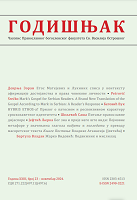Бог зна и прије него што види: Појмовне метафоре у значењима глагола видјети и погледати у преводу масоретског текста Књиге Постања Владике Атанасија (Јевтића)
God Knows Even Before He Sees: Conceptual Metaphors in the Meaning of the Verbs See and Look At in Bishop Atanasije Jevtic’s Translation of the Hebrew Text of the Book of Genesis into Serbian
Author(s): Ljerka JeftićSubject(s): Jewish Thought and Philosophy, Historical Linguistics, Descriptive linguistics, Translation Studies, Stylistics
Published by: Православни богословски факултет „Свети Василије Острошки“
Keywords: God; creation; conceptual metaphor; source domain; target domain; knowledge; see; look at;
Summary/Abstract: The paper is concerned with the metaphorical meanings of the verbs of perception in Serbian – vidjeti (see) and pogledati (look at) – in Bishop Atanasije’s translation of the Hebrew text of the Book of Genesis and in his comments accompanying specific verses. The analysis is set within the framework of cognitive linguistic theory of conceptual metaphor which treats metaphor as a cognitive mechanism in the construction of meaning in thought and language.The construction or understanding of meaning is achieved by way of mentally accessing an abstract target domain in terms of a concrete source domain whereby the term domain refers to any coherent organization of experience. With this in mind, the paper draws on the interpretation referred to by Bishop Atanasije that, in the course of God’s creating the world, God knew even before he saw (that is, knowledge, as the target domain, preceded sight, as the source domain) that what He created was good, but explicates His knowledge by means of the verb of perception (see) for the sake of humans because, as the paper argues in line with cognitive linguistic findings, visual input is one of the most important sources of human knowledge. Hence, the analysis focuses on the role of the verbs of perception with God as the agent in His relationship with the creation, as well as on the metaphorical and metonymic uniqueness of the biblical narration of God’s creation of the world, as contained in the translation of the Hebrew text into Serbian and Bishop Atanasije’s comments. The results of the analysis indicate that the creation is both in God’s knowledge and His sight, that is, God knows and sees the creation as long as it is good, i.e., as He intended it to be. However, once the creation gets corrupt due to humans disobeying God’s commands thus alienating themselves from God’s knowledge and sight, the new relationship is established wherein the creation becomes the object of God’s attention and regard which He continues to care for.
Journal: Годишњак
- Issue Year: 2024
- Issue No: 23
- Page Range: 75-95
- Page Count: 21
- Language: Serbian

